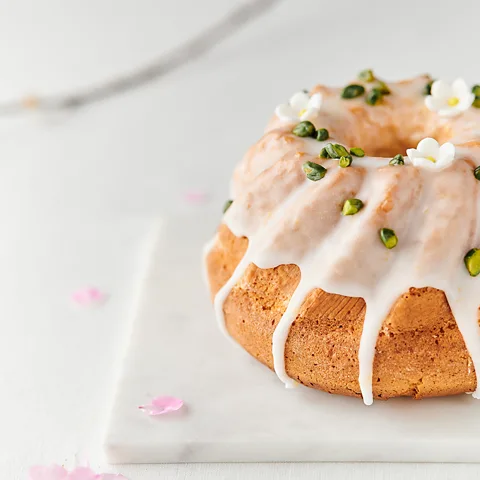The baba is often served at Easter in Poland, with the most extraordinary version – the muslin baba – made from a rich dough of flour, yeast, butter and quite a lot of egg yolks.
Depending on where it’s baked, the baba or babka takes on many different forms. In the US, it’s a braided brioche-like bread that often has chocolate, nuts or other ingredients mixed in. Europeans might be more familiar with baba au rhum, a desert popular in France and Italy that is soaked in liqueur and served in individual portions.
But in Poland, the word “baba” can refer to a variety of baked goods. Some are made in Bundt pans, while others are loaf shaped. Some are more bread-like and use yeast while others more closely resemble pound cake, like the lemon baba I made for my son’s birthday. And some, like the potato babka so popular in Poland’s Podlasie region, are savoury instead of sweet.
The typical yeasted baba is often served at Easter and added to the Easter basket brought to church to be blessed, with the most extraordinary version being the muslin baba named for muslin cloth because of its lightness. It’s made from a rich dough that contains flour, butter, yeast and a lot of egg yolks – 96 of them for every kilogram of flour.
One food website says to “take a deep breath”, as the home version of the muslin baba recipe calls for just 250g of flour, so you will only need 24 egg yolks. By contrast, the Easter baba recipe I usually make contains six egg yolks for 500g of flour (or 12 egg yolks per kilogram), and I already consider that to be a lot.
World’s Table
BBC.com’s World’s Table “smashes the kitchen ceiling” by changing the way the world thinks about food, through the past, present and future.
The original recipe for muslin baba is often credited to the 19th-Century food writer and journalist Lucyna Ćwierczakiewiczowa, an extremely popular and successful cookbook writer at the time. I came across the recipe in two other cookbooks: Jak Gotować (How to Cook) by Maria Disslowa, first published in 1931, and then again in Old Polish Traditions in the Kitchen and at the Table (published in 1979) by Maria Lemnis and Henryk Vitry, both pseudonyms of Polish musicologist Tadeusz Żakiej, which provides fascinating insights into the life and traditions of pre-war Poland.
“The cook, the lady of the house and all the women locked themselves up in the kitchen,” Żakiej writes. “They sieved the whitest of flours, mixed hundreds of egg yolks with sugar in clay bowls, dissolved saffron in vodka.”
This is not the easiest of recipes. It requires long mixing and rising times and keeping an eye on the oven during baking to prevent burning (not to mention having to crack so many eggs). In other words, making baba was serious business.
Some say that the name “baba” (the word for “woman” in Polish) referred to the fact that the dough was finnicky and moody, “just like a woman’s temperament”. And men weren’t allowed into the kitchen during baking as it was thought their presence could lead to a failed, undercooked cake. While the dough was rising, it would be covered in a linen tablecloth and doors and windows were sealed to prevent drafts. After baking, the baba rested on cushions, and because it was thought to be so sensitive until it fully cooled, everyone would whisper because it was believed loud noises would cause it to collapse. Sometimes, after taking the baba out of the oven, the kitchen would be filled with sobbing: “A burned or collapsed baba was a terrible faux pas,” Żakiej writes.
But one question remains, why the extreme amount of egg yolks?
 Lukullus
Lukullus“Egg yolks contain lecithin, which acts as natural leavening agent,” says Jacek Malarski, the co-founder of Lukullus, a Warsaw-based bakery that sells the 96-egg yolk baba (or as they call it, Baba 96). “Adding a large amount of yolks results in a tender and fluffy texture, and adding an extreme amount of egg yolks results in an extremely fluffy texture, like a cloud.”